| Article ID | Journal | Published Year | Pages | File Type |
|---|---|---|---|---|
| 5632238 | Neuromuscular Disorders | 2017 | 4 Pages |
â¢Aim: correlation between neuromuscular junction dysfunction and gait velocity.â¢6MWT and LRNS test were performed in fifteen patients with SMA type 3.â¢Conclusion: The 6MWT identifies fatigue in SMA 3 patients with junction dysfunction.
The aim of the study was to establish if the decrease in gait velocity on the 6 minute walk test relates to signs of neuromuscular junction dysfunction in spinal muscular atrophy type 3 patients. 6 minute walk test and low-rate repetitive nerve stimulation test were performed in fifteen ambulant patients with spinal muscular atrophy type 3 of age between 9 and 66 years. The 6 minute walk distance ranged between 66 and 575âm. The difference between the first and the 6th minute ranged between 0 and â69%. The low-rate repetitive nerve stimulation test measured in % of loss ranged between â31.7% to +4.2% to the axillary nerve. The correlation between 6 minute walk test changes and low-rate repetitive nerve stimulation test changes was 0.86. Our data suggest that the 6 minute walk test can identify fatigue in the ambulant type 3 patients who have a concurrent neuromuscular junction dysfunction. The identification of fatigue with a simple clinical test may help to target patients who may benefit from drugs that facilitate neuromuscular transmission.
